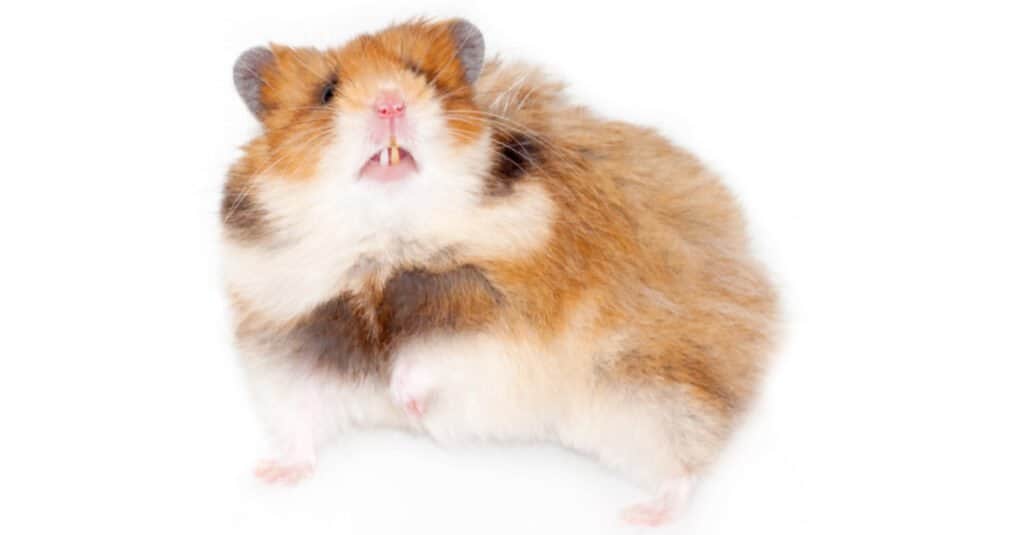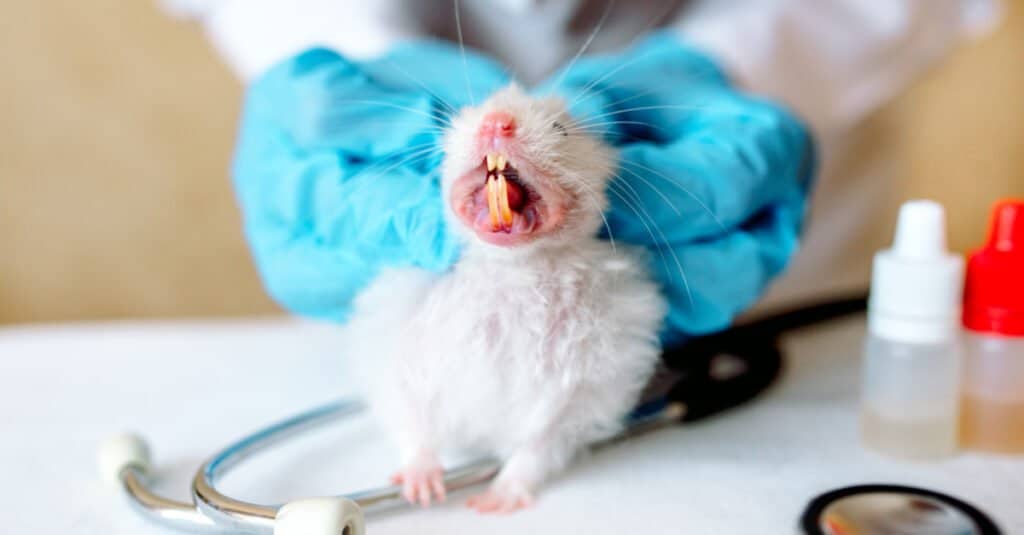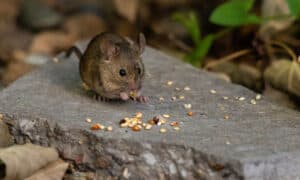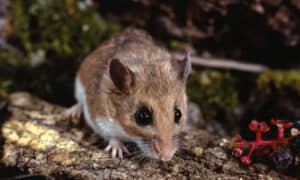Hamsters are members of the rodent family Cricetidae. There are 19 distinct species, and many of them (including the Syrian and Teddy Bear hamster) are popular as household pets because of their cuteness and ease of care. Hamsters come equipped with fearsome front teeth, or incisors, and cheek pouches they use to transport food and bedding. Here, we’ll discover everything you ever wanted to know about hamster teeth, and just why they are the color they are.
How Many Teeth Do Hamsters Have?

Hamsters are born with 16 teeth.
©Natalia7/Shutterstock.com
Hamsters are born with a full set of 16 teeth. They don’t have milk teeth and adult teeth, but only one set that lasts their entire life. They have four incisors; two on the top and two on the bottom. Hamsters have no canine teeth, only a gap between their incisors and cheek teeth called a diastema.
Next are the cheek teeth. Hamsters have 12 total cheek teeth; eight on each side, with eight on top, and eight on bottom. Like the incisors, the cheek teeth are never replaced, and last for the hamster’s entire life.
Incisors
Hamsters use their incisors to groom, grab food, and occasionally-bite attackers. The incisors are long and thin and curve towards the hamster’s head. They aren’t used for chewing, but without them, hamsters would have a difficult time eating, staying clean, and shredded materials for their bedding.
Cheek Teeth
Hamsters have both premolars and molars, but they are nearly identical, and serve the same purpose, so they are generally grouped together as cheek teeth. Cheek teeth are vital for crushing and chewing the tough foods like seeds and grains that hamsters feed on. The irregular occlusal (chewing) surfaces of these teeth do a good job of crushing and masticating tough foods when hamsters chew.
Elodonts: Ever Growing Teeth
Like many rodent teeth, hamsters chompers keep growing for their entire lives. This is because hamsters have a diet that requires a lot of chewing, and if their teeth didn’t keep growing throughout their lives, they would wear out long before the hamster reached old age. The Latin root of the word ‘rodent’ actually means ‘to gnaw’; so you can see why hamsters are considered rodents.
Hamsters teeth are not like human teeth, which only grow once and then wear down over the course of our lives. Unlike other kinds of teeth, hamster teeth do not have true roots. Instead, they have open roots. This allows their teeth to keep growing forever.
Why Do Hamsters Have Brown Teeth?

Hamsters’ teeth are naturally brown or yellow.
©Irishasel/Shutterstock.com
Many first time hamster owners ask the question; why are my hamster’s teeth brown? Or orange? Or yellow? They expect their healthy hamster to have pearly whites, but hamsters have a unique kind of enamel. This enamel develops below the gumline, and helps the hamsters’ teeth continuously grow. And what color is this enamel? It tends to be yellowish orange to brown, and is almost never white.
Yellow or brown teeth are perfectly normal and healthy in hamsters. The older they are, the darker their teeth get. So it’s even possible to tell how old a hamster is by the darkness of its teeth.
Dental Problems
Because their teeth never stop growing, pet hamsters often have tooth issues. If you choose a hamster as a pet, it’s important to provide them with the appropriate diet and plenty of pet safe wood blocks to chew. However, even with a good diet and plenty to chew on, hamsters may still develop dental problems. Let’s take a look at some of the most common issues that plague hamsters’ teeth.
Overgrown Teeth
One of the most common health problems hamsters face is overgrown teeth. Teeth become overgrown when the hamster doesn’t use them enough, either for chewing up tough food or for chewing on things like wood and cardboard. Their teeth keep growing, whether they use them or not, and this can quickly become a problem if they’re not worn down fast enough.
Overgrown incisors can quickly become misaligned, meaning they get so long they actually start growing crooked. They can also pierce the gums or mouth, and may even cause abscesses or infections.
The cheek teeth can become overgrown too, though it’s much harder for owners to see these teeth to know whether they are too long. Overgrown cheek teeth may cause a variety of problems; including entrapment of the tongue and interference with the cheek pouches. Tongue entrapment happens when the cheek teeth get so long that they actually prevent the tongue from moving, which severely impacts the hamster’s ability to eat. Because hamsters have cheek pouches located right next to their cheek teeth, overgrown cheek teeth may actually lacerate the cheek pouches, and could cause infection.
Caries
Hamsters spend much of their lives chewing with their cheek teeth. The cheek teeth are pressed close together, and it’s not uncommon for food to get stuck in between or behind them. Because of this, hamsters are prone to caries (cavities). Left untreated, caries can rot the tooth, and may even cause an infection or abscess. If you suspect that your hamster has any kind of tooth problem, be sure to consult a veterinary specialist immediately.
Prevention

Hamsters need an appropriate diet and plenty to chew to maintain good tooth health
©sirabhop/Shutterstock.com
In order to maintain good tooth health throughout their lives, two things are extremely important for your pet hamster.
First, owners should provide a suitable diet of primarily seeds and hamster formulated pellets. Hamsters can also be give produce and fresh greens, but these should be given sparingly as treats, and should not make up the bulk of the hamster’s diet. Sugary treats should also be avoided, as these can contribute to dental caries.
Second, hamsters love to chew. This means they need more than just food in their enclosure; they need wood blocks too. The best place to buy these is at the pet store, where pet safe, non-toxic wood blocks formulated specially for hamster teeth can be found.
It’s fairly simple to prevent dental problems in your pet hamster with the appropriate diet and chewing supplements, but tooth maladies may still occur. Most issues are treatable by veterinary specialists, who can file or even extract problem teeth.
The photo featured at the top of this post is © Irishasel/Shutterstock.com
Thank you for reading! Have some feedback for us? Contact the AZ Animals editorial team.






